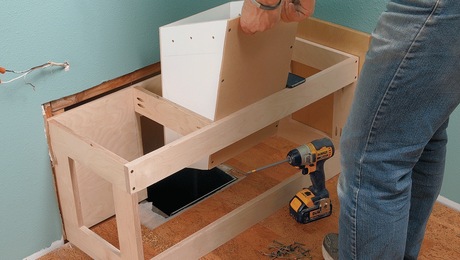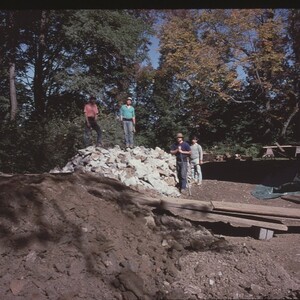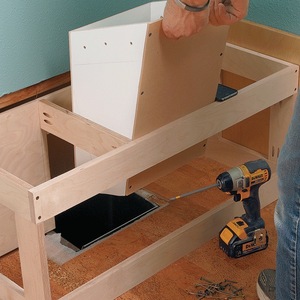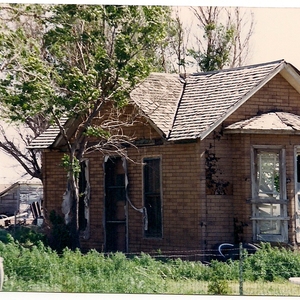Expect to use 1†(3/4†actual) IPE boards on my deck in the Norfolk, VA environs. Had planned for EB-TYs (using a biscuit joiner) to fasten them to joists, but a local pro deck builder who has built several IPE decks swears by a nail gun and 2†stainless steel finishing nails. Both EB-TY and the local craftsman recommend a “thin bead†of construction adhesive atop the joists. Question 1: Which approach (EB-TY vs finishing nails) will best stand the test of time? Question 2: Has anyone used EB-TYs without glue? If so, was it a success? Any squeaks sneak up on you? The 1-800 EB-TY guy said adhesive keeps squeaks from appearing over time and ties the deck together more solidly than the fasteners alone. Gluing such nice lumber to joists just feels weird. It also makes me uneasy if and when the pressure-treated superstructure requires repair 20+ years down the line.
Discussion Forum
Discussion Forum
Up Next
Video Shorts
Featured Story

Learn how to plan, fabricate, and install a chute to conveniently send your dirty clothes from an upstairs bathroom or hallway to your laundry room below.
Highlights
"I have learned so much thanks to the searchable articles on the FHB website. I can confidently say that I expect to be a life-long subscriber." - M.K.

















Replies
Bob,
Another reason the EB-TY system reccommends the construction adhesive, is to take up the voids in the sub-structure. Most deck framing is made up of P.T., and in a lot of cases there is a lot of up and down, crowns and dips, in the P.T. lumber. The EB-TY's are routed or plate joined from the upper surface of the decking. Rather than drawing the decking down to an uneven sub structure, like screw downs and undermount systems, the EB-TY System keeps a smooth, even upper surface and the adhesive fills those voids while maintaining a moisture barrier and extra adhesion qualities thrown in.
Thanks. Have tried to mitigate some of the pressure-treated ups 'n downs through creative joist shimming, and will break out a buddie's power planner to knock down the crowns before installing the decking.
Dropped in on a crew covering a 3,000+ ft2 deck with IPE. They're EB-TYing without adhesive. Makes me wonder.
And the reason they gave for not using adhesive was to allow a small amount of movement... less stress on the deck.
Anyone have any thoughts on this?
i built a deck with1 x 4 ipe with a pressure treated frame on a rooftop in february 2003
i recommended construction adhesive and pin nails and 5/4 material
the architect specified no face fasteners
i now have to replace some boards and face fasten others because they are now twisted
the decking material has shrunk
i built three other decks with pressure treated framework, 5/4 ipe, chemerex adhesive and pin nails with no problems on any of them
What is face fastening? (I'm a novice at this and not in the business... have only built 4 decks. Tried Fiberon on the last one, but I wanted to "up the ante" this time because I may live here for quite some time).
I gather you're not a fan of 3/4" IPE boards. Big difference in price between them and the 5/4. The local IPE lumber yard folks says they sell 5/4 for commercial purposes or if spanning 24" OC. Mine is 16" OC.
bob
the frame i built was 18' 8" x 59' with joists 16" on center
all the deck boards were 18' 8"
face fastening is nailing the boards from above
i then filled the pin holes with some filler made from sawdust
you can not see the nail holes unless you really look for them
lee
I am really interested in your technique.
Personally, I'm in favour of EB-TY & PL Premium. My homeowner has decided to use Ipe, but we have not ordered because he has only rough plans, and I have a lot more sheathing & fixing to do.
Everything I have heard moves me toward fixing the deck down hard and eliminating movement. For the record, we are building an 11'x11' roof over a new room and then framing with PT joists over the old sub-deck (a difference of 18½"), then 2 steps to the Jacuzzi.
I'll be using 5/4 PT sleepers over the new deck and making the deck level all across.
1st time with Ipe. Any other hints?Quality repairs for your home.
Aaron the HandymanVancouver, Canada
i like the qualities of chemerex polyurethane adhesive
i used an occasional toe nail to keep the boards straight when laying out the deck
the advantage of using pin nails is that you do not have to predrill the ipe
i built some picnic tables out of ipe and broke at least three drill bits on each one
to aaron and all others working with Ipe for the first time. wax all end cuts to prevent checking ( cracking at the ends) it will check in dry weather. If its not too late use a different material , Ipe is not tool or user freindly . If you are using ipe for a client charge more.
good luck
What kind of wax? Paraffin? I noticed the Ipe at my local lumber store is waxed, but they didn't know what kind.
Regards,
Tim
Anchorseal is the "wax" I've read about at websites featuring Ipe and also recommended by our local Ipe lumberyard. The standard line is to seal any end cuts within 24 hours to limit checking.
Of note, do the carpenters out there have favorite carbide 7 1/4" and 12" blades for working with Ipe to deliver really smooth cuts? The guys up the street building a 3,000 ft Ipe deck are using Marathon 24 tooth blades in their circular saws. Can't recall the 80 tooth blade they had in their miter saw.
Thanks for the info on wax. Sorry, no help for ya on saw blades. I'm about to do my first Ipe up here in Canada, and I don't know anyone else around here doing it. It's new up here in Canada. I helped build one last spring down in Ohio, that's my Ipe experience.
I figured I'd try a 24T thin-kerf chip-limiting Freud on the circ saw (I was impressed how thin the kerf is). If that's no good, I'll go to more teeth (40 or 60) and/or start shopping for a premium blade. Don't know yet on the miter saw, haven't seen any blades worth buying. Probably end up ordering one and hoping it's good. :-(
Regards,
Tim Ruttan
Aloha Tim, The wax we used was called beeswax . It came in like a pint paint can, and applied with a brush . It was white like a milkshake and hardens to a wax form. We got it from the Ipe distributor. or you can use wes-system epoxy for your end cuts.
Here are some things that i found out while working with ipe . stay away from miter joints , the heal seems to shrink faster and it will make your cut look off . you can design a nice deck with butt joints . Wes system epoxy bonds ipe really good .
lattaz, m&m
You should talk to Pro-Deck about his thoughts on the Eb-Ty system...if I remember correctly he didn't think too much of it.
I counter-sunk and screwed mine down with # 10 ss trim screws, after finding that the hemlock PT joist wouldn't hold an 8 or 9. I plugged the holes with tapered ipe' plugs. I think the fastener size and type you choose should be controlled by how well they hold in the joist material you have. Be sure to use a wax end-grain sealant on your cuts to prevent them from splitting as they finish seasoning. The first project took me twice as long to deck as I thought it would, and that was figured at three times as long as a cedar deck hand-driven with galv casing nails.
The only glue that will grab this stuff, according to the information I've been given by suppliers, is epoxy. I have had success in building up columns in ipe' with epoxy, but found a sanding with 60 grit on the faces dramatically improved my chances of a good bond.
If you have a good grade of PT material, it won't need repair in twenty years. The ipe' itself is supposed to be good for twenty years with no maintenance in a marine environment, so I don't think you should worry about having to take the thing apart. I'm going to take a guess that when this material does move seasonally, the density of the material will allow it to take most any fastener and pull it loose from it's joist. 1 3/4" penetration into joist with a 2" finishing nail just isn't anywhere close to enough holding power in my book.
my $ 2/100
remember, dust masks with this stuff. had a terrible two weeks with painful lungs after a small deck without breathing protection...
We did an ipe deck about a year ago and used 3M marine epoxy and an occasional stainless trim head screw (2-3 per 16 ft board) to keep them straight until the epoxy set. It did great and the screws just disappear. We glued a few sample pieces before hand with Liquid Nails, PL 400, and the epoxy and the epoxy clearly held better. Good luck!
Eric
Edited 6/15/2003 8:13:29 PM ET by EPINKSTON1
You epoxied the deck down, and that's it? Wow, you have cajones, senor. Pray tell, what was the joist material below, and did you prep it somehow to increase the bond? This method sounds neat, if it holds up after freeze/thaws and foot traffic...
Really appreciate the info, Wegemer and Woodexp. So you think the guys who are building the Ipe/EB-TY deck not far from me without adhesive are asking for problems, eh?
Why do you think the 3/4" Ipe roof deck is having problems? Is it just too hot?
My guess is the boards that twisted were underfastened. Since it was a rooftop deck there may be a really humid environment below the deck surface with some standing water, and the direct sun on the exposed side is probably making the boards expand and contract quite a bit. Not only does ipe' shrink after installing quite a bit, it also swells quite a bit. It may have tugged some fasteners loose and once free of them was able to move at will. This is why I can't see a bead of epoxy lasting very long. I used the best marine epoxy I could find, and still had bonds that were marginal in places. I didn't explore the why of it, at the time. It may be that grain orientation plays a role in the bond. I may have used the wrong epoxy.
I've never used the Eb-Ty, so I don't have an opinion of it, myself. Only heresay from Bob Pro-Deck, who if I recall correctly thought they were a piece of Chevy...
Maybe you could ask those guys when their nearing completion of their project what they think of that system then.
Edited 6/18/2003 3:14:14 AM ET by WEGEMER
Like Mr. Wegemer states I am not a big fan of EB-TY's. They are great for the homeowner that has lots of time and patience, but I would like to build more than one deck per month.
I would never try to nail this stuff down and expect it to hold. Pre-drilling and face screwing is really the best way to fasten IPE. We also like to use a case hardened hot dipped screw instead of stainless because stainless screw heads can strip out or bust when you drive them into a knot. then you have the fun of backing them out.
If you want to glue your joist then drag your air hoses and cords over the glue be my guest. I told EB-TY it is not the fastener that makes the squeak, it is the flex of one wood against the other and there is not an outdoor glue made that will adhere the two surfaces together.
Here is a shot of the EB-TY system. The bench was face screwed and plugged. Bob
"Rather be a hammer than a nail"
Really appreciate your thoughts, Pro-Deck, and the good pics. As Harry Homeowner, I can take the time to dawdle while building this thing (already have... lots!). So, what's another bizillion hours spent with a biscuit joiner and EB-TYs, eh? Think I'll try it without adhesive. And pray.
You'll do fine w/o the glue. If the glue held at all I would think it would hinder the expansion and contraction of the decking. It really is better to let your lumber move about.
It's better to let your belt out a notch after a big meal isn't it?
Well your deck will need to do the same after 15 people get puffed on BBQ burgers and walk all over it.
:-)Bob
"Rather be a hammer than a nail"
Hey Pro
If your looking to get away from the plate joiner or router to make the kerfs, Thompson Mahogany is making the side kerfs in the Ipe. All you have to do is slide the EB-TY into the groove. I believe a few other Ipe importers are starting to grasp the idea.
Sounds great! That would certainly save everyone ALOT of time.Bob
"Rather be a hammer than a nail"
Bob, I was thinking of plugging screwholes in Ipe. I've got the carbide plug cutter. What glue did you use, Gorilla? Did you use a regular flush-cutting saw on the plug? I've got a flush plane but don't know how effective it'll be against Ipe.
Regards,
Tim Ruttan
Tim,
Yes, we used Gorilla glue. You can use a thin bladed flush cutting saw but we just used a belt sander with the grain of course.
I'm not sure how well a plug cutter would work because the plugs would be straight sided. We had a hard time putting in tappered plugs.
Don't glue your fingers together :-)Bob
"Rather be a hammer than a nail"
Thanks, Wegemer. You've been most helpful.
I built a couple of Ipe decks and found that the Deckmaster system works better than the Eb-ty system. Deckmaster gives you galvanized metal profiles that you screw to the joists. Then you attach the boards by screwing through the Deckmaster profile into the board from underneath. Not easy, but there is not a hint of fastener visible from above. You can use marine adhesive under the boards, but it is not necessary. Premium PL is great all around, but in a deck situation I would not recommend it. It gets very hard and does not flex at all. So when the decking expands and contracts, it breaks the bond.
Kroozer
Aloha, I am currently working with Ipe 1x decking . We are using 1x6 to deck
about 1200sq.ft. of deck in tropical hawaii . I found out that Ipe shrinks alot
in this hot dry weather . We started using Ebtys It didn't seem very solid and
it wasn't helping the shrinkage factor, the decking was coming loose. So after some
trial and error with ebtys , nails some glues we came to the conclusion that the best
application was the old faithful skrews and plugs. The decking came out sweet.
The plugs complimented the wood. Ipe is the type of wood the will last for a
long time so stick to the ways that stood the test of time.
hang loose brahdda,